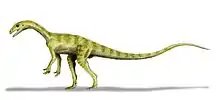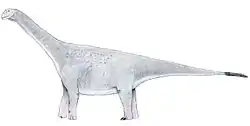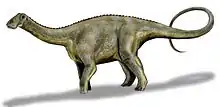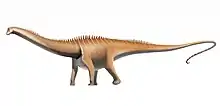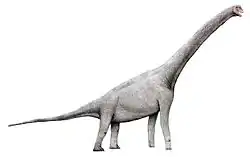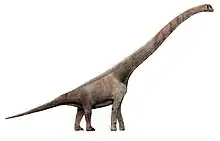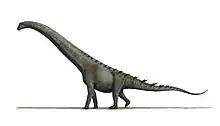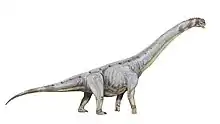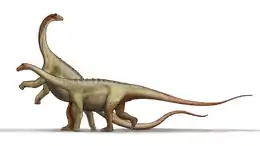Quaesitosaurus
Quaesitosaurus (meaning "extraordinary lizard") is a genus of nemegtosaurid sauropod containing only the type species, Q. orientalis, described by Kurzanov and Bannikov in 1983.[1] It lived from 75 to 73 million years ago during the Late Cretaceous (Santonian to Maastrichtian ages). Its fossils, consisting solely of a partial skull designated as the holotype PIN 3906/2, were found in the Barun Goyot Formation near Shar Tsav, Mongolia.[1] With long, low and horse-like with frontally located peg-teeth, the skull of Quaesitosaurus is similar enough to the skull of Diplodocus and its kin to have prompted informed speculation that the missing body was formed like those of diplodocids.[2]
| Quaesitosaurus Temporal range: Late Cretaceous, | |
|---|---|
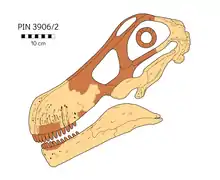 | |
| Diagram showing known elements of the holotype skull | |
| Scientific classification | |
| Kingdom: | Animalia |
| Phylum: | Chordata |
| Clade: | Dinosauria |
| Clade: | Saurischia |
| Clade: | †Sauropodomorpha |
| Clade: | †Sauropoda |
| Clade: | †Macronaria |
| Clade: | †Titanosauria |
| Family: | †Nemegtosauridae |
| Genus: | †Quaesitosaurus Kurzanov & Bannikov, 1983 |
| Species: | †Q. orientalis |
| Binomial name | |
| †Quaesitosaurus orientalis Kurzanov & Bannikov, 1983 | |
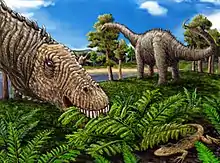
It is possible that Nemegtosaurus, also known from only skull material, is a very close relative of Quaesitosaurus.[2][3]
References
- Kurzanov, S. M.; Bannikov, A. F. (1983). "A new sauropod from the Upper Cretaceous of Mongolia". Paleontological Journal. 2: 90−96.
- Hunt, A.P., Meyer, C.A., Lockley, M.G., and Lucas, S.G. (1994) "Archaeology, toothmarks and sauropod dinosaur taphonomy". Gaia: Revista de Geociencias, Museu Nacional de Historia Natural, Lisbon, Portugal, 10: 225–232.
- Wilson, J. A. (2005). "Redescription of the mongolian sauropod nemegtosaurus mongoliensis nowinski (dinosauria: Saurischia) and comments on late cretaceous sauropod diversity". Journal of Systematic Palaeontology. 3 (3): 283−318. doi:10.1017/S1477201905001628.
